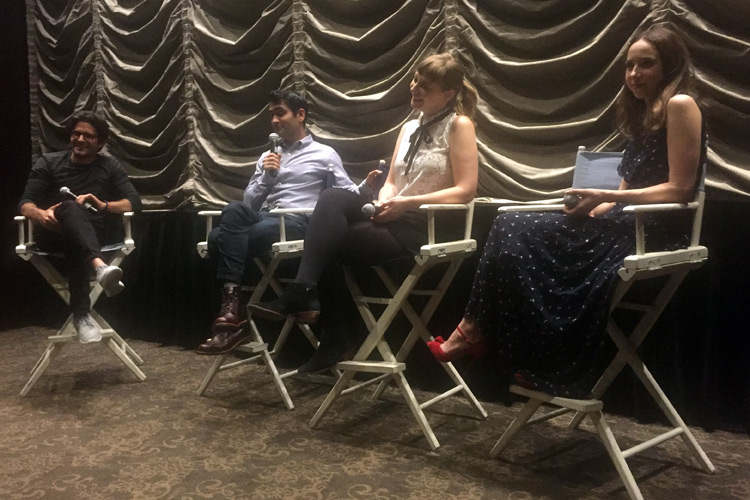The following questions and answers are excerpted from a conversation that followed the NBR screening of The Big Sick.
How long did it take for you both to adapt your own experiences for the screen?
Emily Gordon: We started writing this five years ago, which is five years after the events of the movie. We had enough distance to not talk about it without crying all of the time while still being able to access those emotions. We were working with Judd Apatow, who is fantastic, but very hard on the script, as well as Barry Mendel, who was harder on the script. We’d take in a draft every few months and he would rip it to shreds and we’d start over.
Kumail Nanjiani: For basically the first two years we’d write and rewrite, but it wasn’t our primary job. It wasn’t like we were writing for three years non-stop. We took bathroom breaks and I had to catch up on all of the Transformers movies.
The handling of time in the script is incredible, at what point did you find the right timing and rhythm for this film?
Gordon: The editing room.
Nanjiani: Well, we talked a lot about it while we were writing. Even though we’re vague about how long she’s in the coma and how long after the coma, we really did map it all out. Each scene in the first act is a different step of their relationship, so that Emily is opening herself up and sharing apart of herself.
Gordon: The relationship part was built in the editing room based on test screenings of the moving parts of their relationship. We wanted to make sure people understood that time had passed, but there is still this big thing that is looming.
Nanjiani: One of the big things we took out initially was that montage of me and Emily getting to know each other and my mom having more women show up. We took that out, thinking that there wasn’t a lot of story going on. We were wrong though because that conveys the sense of time passing and ratchets up tension.
“Ultimately though, it was us deciding what to listen to and take to heart.”
What was the test screening process like? How do you remain protective over what you created and not have it too overexposed?
Nanjiani: With us, it was listening to everything. Some stuff is just ludicrous though. One person was like, “I don’t think people from different races should be in a relationship together.” He stayed until the end thinking there was going to be a great twist. Maybe I toss a quarter into a well and turn white. So there are things like that you dismiss and then people say things that you disagree with, but if we had multiple people saying the same thing we’d have a conversation. Ultimately though, it was us deciding what to listen to and take to heart.
What was it like bringing on and working with Michael Showalter? How did you go about the rehearsal process with him?
Gordon: We’ve known Showalter for many years and knew he could do it after watching “Hello, My Name is Doris.” After that we had a conversation where he pitched to Judd and us what he wanted to do with the movie and Judd said “ok, go start working.”
Zoe Kazan: We had already broken down the text of that scene in the Judd Apatow and Barry Mendel brain trust way, but still about three weeks before shooting we went over to Michael Showalter’s apartment and hashed through the scenes. It was hard because when you talk about a break-up, it’s emotional and we have different fighting styles, so when we’d improvise it would go off the rails and when we followed the script there were boundaries that we had to figure out how to cross together. It felt like Michael was almost like a marriage counselor that day because he was so calm.
Nanjiani: I had forgotten about that until just now. A lot of that scene came out of us doing those rehearsals because we had to get each other to that place where we are playing off of each other to escalate the scene.
Can you talk about casting and working with Ray Romano and Holly Hunter?
Gordon: Holly was the first choice. If you have a chance to work with Holly, you’re not going to think about who else you may have.
Nanjiani: She was the first choice for every role.
Kazan: She approached it as if she were doing “The Piano” again. She brought so much preparation. In my first costume fitting, the costume designer was like, “Holly bought you guys these necklaces. You wear this one and she’ll wear the other one, so they’re matching and you have this mother and daughter connection.” I’m like… whatever Holly says! And the thing about the sweater that’s mine that she picks up is not scripted. The blanket she puts on me was her child’s blanket. The flower crowns I was totally against, but she insisted. She was like “if my child survived this, I would want flowers everywhere.” I just agreed. She won.
Nanjiani: It works because it was very clear that she did not want the flower crown. First thing she does is take off the flower crown.
Gordon: Ray was Judd Apatow’s idea, but we were totally for it since Holly and Ray are completely different human beings. He brought acres of dad jokes all over the place.

